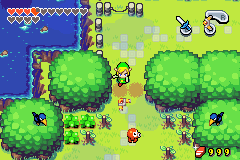 The Legend of Zelda: The Minish Cap
The Legend of Zelda: The Minish CapCapcom, for Nintendo
Gameboy Advance
July 1, 2005
Just when I'm ready to write off the Gameboy Advance to the videogaming retirement home, along comes the new Zelda to drag me back in. I'm beginning to feel a little like Al Pacino, at least during the two weeks I spent with this game.
Not that I mind, because I've always loved the Legend of Zelda games, and I certainly love this one. It's clearly as good as any of the traditional, two-dimensional games in the series. It feels very much like a grand celebration of the whole series, and brings it back to its roots. And yet, the game never feels derivitive or bereft of ideas. Far from it.
The big innovation with The Minish Cap are kinstones, mysterious medallion fragments that can be found lying around everywhere. These fragments can be fused with other people, if they are in the mood (as shown with a little thought balloon over their heads), and successful fusions can result in any number of surprises.
So what happens when you fuse kinstones? You know I'm not going to give that away. Most of the fun in Zelda comes from the endless surprises around the corner. To give any of them away is worse than giving away the ending to a murder mystery novel.
In other words, you're on your own. And, yeah, there will be times when you feel that in your bones. Just trust me when I assure you that all the hunting around and harrassing of people in town will be worth the effort. It took me two weeks before I uncovered all the kinstones and received the final reward, so you'll do fine.
I'm always struck by how Capcom has mastered the feel of the classic Zelda games. It seems now that they've mastered it as well as Shigeru Miyamoto and his teams, and they should be trusted to continue the franchise into the future. I would love to look forward to a new Zelda as enchanting and engrossing as this one has been.
In addition to rumbling through the classic terrain of Hyrule - with a very keen eye towards the original Legend of Zelda from 1986 - you have the ability to travel into the tiny world of the Minish. These amusing little elves live in the forest and among the townspeople, who only know them as stories for children. The young Link discovers a talking cap which looks a lot like Crow T. Robot, and earns the abiltiy to shrink down to Minish size.
It's a classic Miyamoto convention to take a game world and absolutely pack it with gameplay features and little details. It's a great trait of getting the most out of the available space that goes back to the humble 8-bit days when, literally, every byte counted. The Minish Cap continues this lesson wonderfully. A few critics have complained that the world in this game is shorter than the typically epic length for a Zelda game, but they're simply not paying attention. There's so much backtracking and moving around that you'll be more than busy enough.
Personally, I'm growing tired of the notion that a videogame's quality is related only to its length to finish. Too many designers stick us with padded gameplay or pointless errands, for no better reason than to burn out the clock. I'd still rather spend a quarter on Ms. Pac-Man than the current crop of console titles.
I have to wonder if some of the people responsible for the Mega Man games worked on this one. The Minish Cap takes a great influence from Capcom's classic series, particularly in its weapons and dungeons. The one real flaw of previous Zelda games is that the many weapons you acquire are rarely necessary; here, it's a necessity. I've often had to switch back and forth, between a portable vacuum pump, a boomerang, and a pair of claws.
We see this play out in the dungeons. While there are only a half dozen proper dungeons, these are superbly designed, more organic and natural, and really require you to figure your way out of a jam. The final dungeon plays out just like an assault on Dr. Wily's castle, as you wind up heavily using everything in your arsenal, and getting your butt whupped in the process.
In addition to the kinstones, there are mysterious seashells, parlor games, crazy errands back and forth, collectible minatures, samurai trainers, and goofy characters large and small. This land of Hyrule has never been so densely populated, and it gives a great sense of atmosphere. This is a game that just feels inspired, full of life.
And it needs to be said, Minish Cap looks wondrous. This is probably the best use of color and animation in a Gameboy Advance game, and yet again shows how capable the handheld is when put in the right hands. It's just like buttah.
It is no small observation when I say that no other games on the shelves seem to grab my interest. That's what a wonder like The Minish Cap does; it reduces everything else to mediocrity. There won't be a better game than this for quite some time.
No comments:
Post a Comment